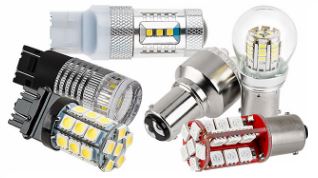LEDs are rapidly taking over from regular light bulbs in car lights.

- They are more robust than bulbs because they don’t have a fragile filament.
- LEDs are more efficient too so for a given power they give off more light and less heat.
- LEDs are long life. Typically they will dim to about 70% brightness over 50,000 hours. They “die” gradually compared to the bulb’s sudden death when the filament breaks.
- LEDs turn on faster than a light bulb which might take 200 ms. This means that the car behind you could see your brake lights 200 ms sooner giving about 6 m earlier brake application at 100 kph.
LED bulbs are available in sizes for all popular interior light applications including festoon and bayonet styles for tail lights, turn signals, side marker lights or any other exterior lights.
Turn signal indicators

Older cars – probably all classics now – used a bi-metallic strip contact for the flasher. The current ran through the contact and when it warmed up (in about half a second) the contact opened turning the lamp off. It cooled down in about the same time and turned back on again. They had the nice feature that if one bulb failed the flash rate would slow down to about half and alert the driver to the fault. Some electronic flashers mimic this behaviour.

